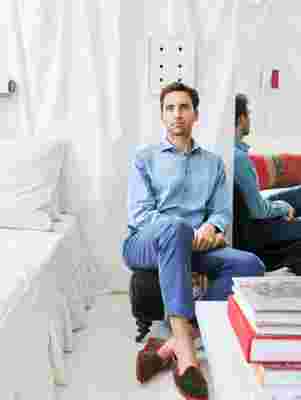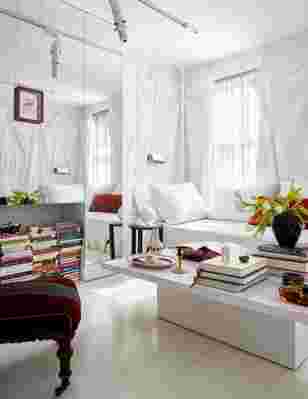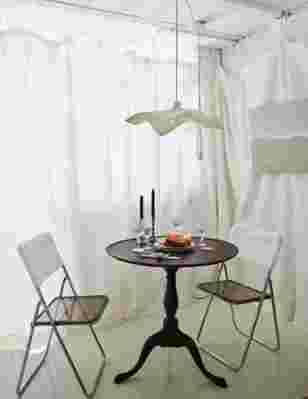Tour Designer Will Cooper's Manhattan Home
Research, research, research,” says designer Will Cooper, musing about his creative process. “I have to be in a place and get the vibe—visiting all the museums, poring over books, and unpacking everything from there. Ideas come and go. They blend together with discoveries from my travels. It all becomes this convoluted mix.”

The designer at home.
In this particular instance, he is referring to the hit hotel projects he has shepherded as chief creative officer and partner of the AD100 firm ASH NYC , from the terrazzo-tiled baths at The Siren in Detroit to the gingham-bedecked boudoirs at Hôtel Peter & Paul in New Orleans. Still he might as well be describing his own recently redecorated Manhattan home, a one-bedroom rental in Alphabet City. Just 550 square feet, with a railroad-style warren of rectilinear rooms, the apartment reveals a masterly mix of references, styles, and finds—the result of both his professional peregrinations and deep dives into the annals of the decorative arts.

The East Village apartment of Will Cooper, Chief Creative Officer and partner of the AD100 firm ASH NYC .
Inspired by Renzo Mongiardino and John Dickinson, ribbon-tied panels of white cotton cocoon the walls, creating an undulating maze of flexible partitions. (“Living in a drywall box, I asked myself what could I do that wasn’t paint but that was still textural, decorative, and functional.”) Track lighting and vertical aluminum blinds, meanwhile, nod to the 1970s High-Tech hallmarks of Joe D’Urso. “It’s kind of like theater,” notes Cooper. “You can shape the light beams, move them to highlight whatever is interesting. At night it’s incredible.” Additional fixtures—’60s sconces by Jo Hammerborg, a ’70s table lamp by Harvey Guzzini, ’70s floor lamps by Robert Sonneman—enhance the drama, bouncing light off the mirrored folding screen and fireplace surround. “The whole room becomes reflective,” he says, adding that the amply cushioned daybed and Aesthetic Movement chairs regularly welcome friends for cocktail hour (albeit not during the pandemic). “I can fit 15 people comfortably, just lounging around Turkish-style.”

In the dining area, Cooper mixed an antique pedestal table with a 1970s Mario Bellini pendant light and Italian folding chairs.
Vintage Robert Sonneman floor lamps flank the bed, which he slipcovered in a patchwork quilt.
Come party time, there is no shortage of conversation starters. Those chairs, he explains proudly, retain their original velvet upholstery and beadwork. That 18th-century Dutch chest he found at Paris’s Marché aux Puces . The cocktail table he designed himself. And the antique Venetian console, cleverly wall-mounted over the drapery, reveals a still life of treasured keepsakes, among them a Playbill for To Kill a Mockingbird (“the last show I saw on Broadway before lockdown”) and an urn that he bought from the Michigan-based collective Hamtramck Ceramck while working on The Siren.
A framed artwork by Aleksandar Duravcevic hangs above the 18th-century chest.
Consider Casa Cooper a scrapbook of life and work. White slipcovers offer his take on summer dress, a New Orleans tradition he fell for designing Peter & Paul. Fitted over his bed, meanwhile, is a quilt that belonged to his great-grandmother and hints at the quilt program to come at ASH’s new Baltimore hotel. (“The city has this historic, very specific pattern,” notes Cooper.) Remarkably, in his hands, all these many ideas yield a breath of calm, not some mad laboratory. “All day I create intense fantasies,” he reflects. “At home, I need some clarity.”
Wall-mounted, an antique Venetian console appears to float against the white cotton drapery.